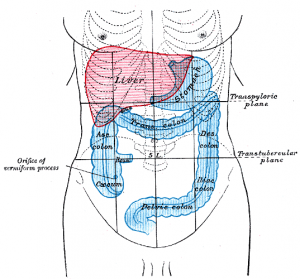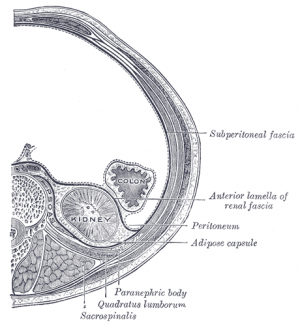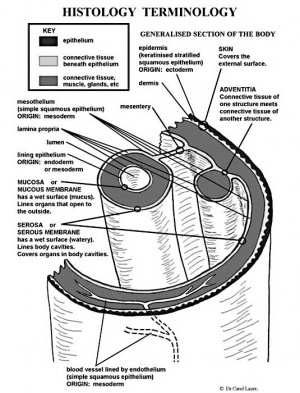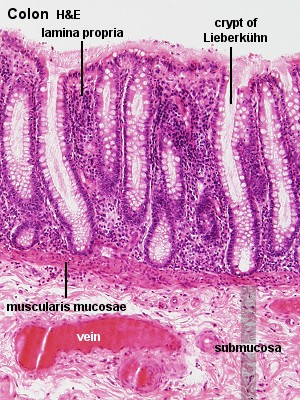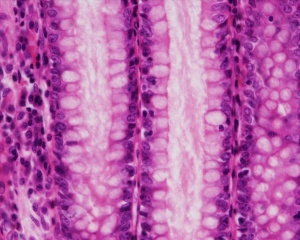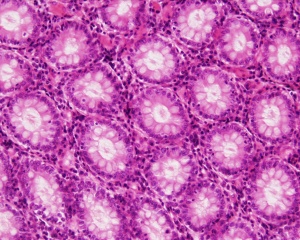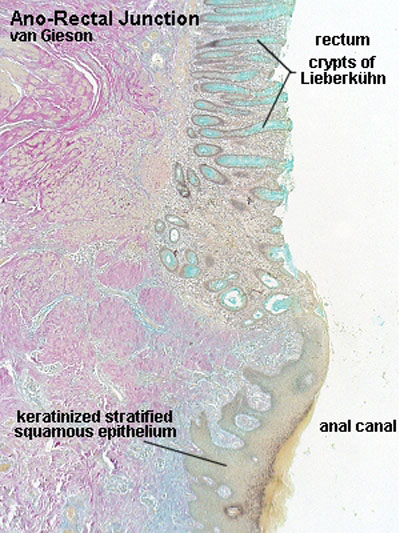Gastrointestinal Tract - Colon Histology
| Embryology - 28 Apr 2024 |
|---|
| Google Translate - select your language from the list shown below (this will open a new external page) |
|
العربية | català | 中文 | 中國傳統的 | français | Deutsche | עִברִית | हिंदी | bahasa Indonesia | italiano | 日本語 | 한국어 | မြန်မာ | Pilipino | Polskie | português | ਪੰਜਾਬੀ ਦੇ | Română | русский | Español | Swahili | Svensk | ไทย | Türkçe | اردو | ייִדיש | Tiếng Việt These external translations are automated and may not be accurate. (More? About Translations) |
Introduction
This section of notes provides an overview mainly of adult colon histology, see also notes Intestine Development.
Page also provides further histology background information for Medicine phase 1 Ageing and Endings - Practical Virtual Slides.
This practical class will initially provide an overview of the microanatomy of the normal colon, and discuss the functional significance of the various histological structures. The second part, and majority of the class time, will study of the histopathology of colonic neoplasms. This current page covers only the normal colon histology. This page content is not part of the AE practical class.
Colon Function
- Reabsorption of water and inorganic salts.
- Secretion of mucus that acts as a lubricant during the transport of the intestinal contents.
Large Intestine Structure
- large intestine - cecum (+appendix), colon, rectum (+anal canal)
- colon anatomically four parts - ascending, transverse, descending, and sigmoid.
- layers from lumen outward - mucosa, submucosa, nuscularis externa, adventitia/serosa
Objectives
- The aim of this practical class is to relate the normal histology of the colon to its function, and to contrast this with the changes that occur in colonic neoplasia.
- The histopathology of colonic neoplasms will be correlated with common clinical features and the biological behaviour of the disease.
Textbook
- Kumar, V., Abbas, A.K., Fausto, N. and Mitchell, R.N. (2007). Chapter 15. In Robbins' Basic Pathology (8th ed., pp. 579-586). Philadelphia, PA: Elsevier Saunders
Slides
UNSW Virtual Slidebox Virtual Slidebox Phase 1 Histology and neoplasms of the colon | Original Virtual Slidebox Phase 1 | Histology Stains
Identify
- A mucosa within which exists the epithelium, the intestinal glands (glands of Lieberkuhn), lamina propria and muscularis mucosa. Note that there are NO plicae circulares or villi in the colon but temporary folds exist instead.
- A submucosa
- A muscularis externa containing inner circular and outer longitudinal smooth muscle layers. Note that taeniae coli are not present in this section of colon (Taeniae coli represent 3 broad longitudinal bands of smooth muscle)
- The outermost serosa (Note that the serosa covers the transverse and sigmoid colon and are attached to the body wall by a mesentery which contains loose CT, adipocytes, blood vessels and nerves. The ascending and descending colon are retroperitoneal and the outer layer on their posterior surface is the adventitia)
- Lymphatic nodules in the lamina propria and submucosa
- A myenteric (Auerbach) nerve plexus (parasympathetic) exists between the muscularis externa layers.
Colon Histology
Crypts of Lieberkühn - (intestinal gland, intestinal crypt) Longitudinal | Transverse
- Colon Histology Links: Ano-Rectal Junction Overview Labeled | Colon Wall Labeled | Colon Mucosa Labeled | Colon Overview | Ano-Rectal Junction Overview | Intestinal Gland - longitudinal van Gieson | Intestinal Gland - transverse van Gieson | Intestinal Gland - longitudinal H&E | Intestinal Gland - transverse H&E | GIT Histology | Gastrointestinal Tract Development
Links
- UWA Blue Histology Gastrointestinal Tract - colon
- UNSW Virtual Slidebox Virtual Slidebox Phase 1
- Virtual Slidebox of Histology (USA) Gastrointestinal tract | Human Colon
- Anatomy of the Human Body (H. Gray, 1918.) historical anatomy text The Large Intestine
- Medline Plus Colorectal polyps | Colorectal Cancer
- Search NCBI Bookshelf - colon histology | Pubmed - colon histology
Terms
- adenoma - clinical term for a tumour of glandular origin.
- adipocytes - fat cells. In the large intestine seen clustered within appendices epiploicae.
- adventitia - (tunica adventitia) outermost connective tissue layer covering the gastrointestinal tract of the ascending colon, descending colon and the rectum (retroperitoneal structures are covered in adventitia, peritoneal structures are covered in serosa). The transverse colon is peritoneal and therefore covered in a serosa.
- anal columns - the 5 to 10 longitudinal folds formed by the mucosa of the anal canal, each column contains a terminal branch of the superior rectal artery and vein.
- ano-rectal junction - a site of rapid tissue transition in structure and function. Epithelial histology changes from rectum (simple columnar, Crypts of Lieberkühn) to anal canal (stratified squamous epithelium) becoming keratinized.
- appendices epiploicae - small pouches in serosa filled with fatty tissue.
- Auerbach's plexus - (myenteric plexus) part of the enteric nervous system lying between outer longitudinal and inner circular layers of the muscularis externa. Embryologically formed from neural crest cells.
- cecum - blind pouch portion of gastrointestinal tract that forms the beginning of the large intestine.
- contraction - colon has two forms of muscular contraction: segmented (local) and peristaltic (movement of contents).
- Crypts of Lieberkühn - (intestinal gland, intestinal crypt) named after Johann Nathanael Lieberkühn a historic German anatomist.
- external anal sphincter muscle - thick region of circular skeletal muscle located at ano-rectal junction under the skin.
- FAP - (familial adenomatous polyposis)
- goblet cells - simple columnar epithelial cells that secrete mucus, named by the cell's goblet-like shape.
- haustra - small pouches generated by sacculation, due mainly to taenia coli shorter length.
- HNPCC - (hereditary nonpolyposis colorectal cancer)
- internal anal sphincter muscle - thickened region of muscularis externa circular smooth muscle located at ano-rectal junction.
- intestinal gland - (Crypts of Lieberkühn, intestinal crypt)
- lamina propria - (lamina propria mucosae) the layer of loose connective tissue beneath the gastrointestinal tract epithelium and with the epithelium form the mucosa.
- lymphatic nodules - most abundant in the cecum and vermiform appendix, but also irregularly scattered over the rest of the colon.
- Meissner's plexus - (submucosal plexus) part of the enteric nervous system lying in the submucosa layer. Embryologically formed from neural crest cells.
- mucosa - the gastrointestinal tract epithelial layer, lamina propria and muscularis mucosa together form the mucosa. The large intestine mucosa is relatively smooth and there are no plicae circulares or intestinal villi present.
- muscularis externa - gastrointestinal tract outer smooth muscle layer formed generally by an inner circular and an outer longitudinal layer, in the colon the outer layer form the taenia coli.
- muscularis mucosa - thin layer of smooth muscle outside the lamina propria and separating it from the submucosa of the gastrointestinal tract, this layer ends at the recto-anal junction.
- myenteric plexus - (Auerbach's plexus) enteric nervous system lying between outer longitudinal and inner circular layers of the muscularis externa. Embryologically formed from neural crest cells.
- pectinate line - anal canal small mucosal folds between the anal columns (anal valves).
- retroperitoneal - (extraperitoneum) the anatomical space in the abdominal cavity behind (retro) the peritoneum space, used to describe structures, organs and tissues located in this region.
- sacculation - process of pouch formation, the colon pursed out to form little pouches.
- serosa - outermost connective tissue layer covering the gastrointestinal tract in regions where it passes through body cavities.* submucosa - dense irregular connective tissue that supports the mucosa.
- submucosal plexus - (Meissner's plexus) part of the enteric nervous system lying in the submucosa layer. Embryologically formed from neural crest cells.
- taenia coli - three longitudinal smooth muscle bands around the large intestine gastrointestinal tract.
- vermiform - (Latin, vermis = "a worm", and forma = "shape") having a worm-like shape, as in the appendix (vermiform appendix).
Glossary Links
- Glossary: A | B | C | D | E | F | G | H | I | J | K | L | M | N | O | P | Q | R | S | T | U | V | W | X | Y | Z | Numbers | Symbols | Term Link
Cite this page: Hill, M.A. (2024, April 28) Embryology Gastrointestinal Tract - Colon Histology. Retrieved from https://embryology.med.unsw.edu.au/embryology/index.php/Gastrointestinal_Tract_-_Colon_Histology
- © Dr Mark Hill 2024, UNSW Embryology ISBN: 978 0 7334 2609 4 - UNSW CRICOS Provider Code No. 00098G
